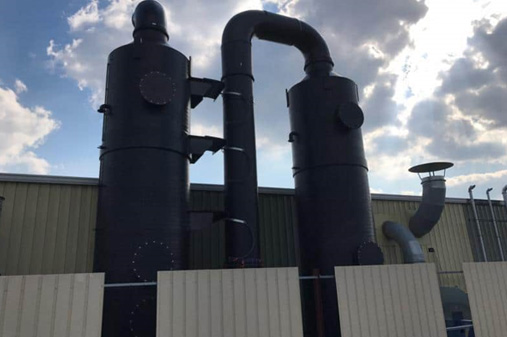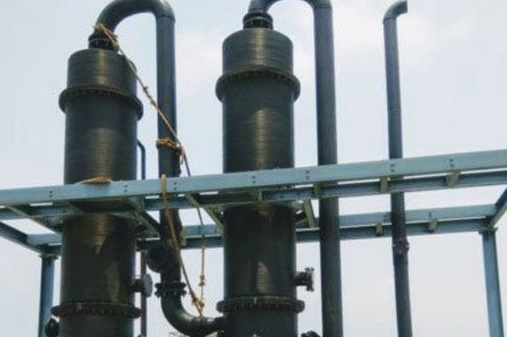Scrubbing Systems/ Pollution Control Equipment
Scrubbers are air pollution control devices that use liquid to remove particulate matter or gases from an industrial exhaust or flue gas stream. This atomized liquid (typically water) entrains particles and pollutant gases in order to effectively wash them out of the gas flow.
Types of Scrubbers
- Wet Industrial Scrubbers
- Dry Industrial Scrubbers
- Venturi Scrubbers
- Spray Towers/Columns
Uses
- Can handle flammable and explosive dusts with little risk
- Provides gas absorption and dust collection in a single unit
- Provides cooling of hot gases
- Compact; can often be retrofitted into existing collection systems
- Corrosive gases and dusts can be neutralized
Design data:
The liquid-gas ratio (L/G) in a scrubber is the relationship between the scrubbing liquid flow rate and the gas stream flow rate. For dimensioning purposes, and to evaluate the workings of a scrubber, it is important to know how much liquid is required per m³ to realise the required residual emission. The L/G ratio is not only determined by the required residual emission, but is also partly determined by the concentration of the to-be-removed substance(s) in the gas stream and the in and out-going liquid streams. The L/G ratio in a particular situation is thus determined by the selected scrubbing system, the properties of the to-be-cleaned gas, the scrubbing liquid and the to-be-removed component(s) and the requirements set for residual emissions.
Variants
Flow direction gas and liquid
Scrubbers can be distinguished in terms of the flow direction of the gas in relation to the liquid. A distinction is made between counter-flow, co-current and cross-flow scrubbers.
In counter-flow scrubbing the scrubbing liquid and the to-be-cleaned gas flow in opposite directions. The main advantage of counter-flow scrubbing is that the cleaner the gas becomes, the lower the pollutant concentration in the scrubbing liquid becomes – whereby the driving force is maintained throughout the column. This type of scrubber is, for example, particularly suited to irregular and peak emissions. The counter-flow set-up allows high concentration peaks to be better dealt with.
In co-current scrubbers, the gas and liquid stream move in the same direction. They are less effective than counter-flow scrubbers. However, the advantage they offer is that they are suited to high gas and liquid loads. Co-current scrubbers have a more compact construction and are normally considered when limited space is available and a lower yield is acceptable. Further, they are effective as an initial scrubbing stage for a counter-flow scrubber, for example, when the gas flow needs to be cooled or partly separated.
In cross-current scrubbers, the gas and the liquid move across one another. For vapour-like components, the liquid will normally flow in a downward direction and gases will flow horizontally. In dust scrubbing, the sprayers will be horizontal to the gas flow. This type of scrubber is more compact than a counter-current scrubber, if one works with a multi-stage set-up, and uses less electricity. A cross-current scrubber is suited to emissions with known maximum concentrations, thus allowing it to be dimensioned appropriately. In case of very high concentration peaks, for which the scrubber has not been dimensioned, the scrubbing liquid will be saturated before it reaches the bottom of the packing. This means that a part of the air will not be (fully) treated, with yield loss as a result.
Gas scrubber with or without built-in device:
Gas scrubbers can also be distinguished by the set-up of the wash section, e.g. with or without a built-in device. The built-in device could be a bulk or structured packing or a construction with plates or a rotating disk. The main layout can be further broken down as follows:
Gas scrubbers without built-in device:
- Spray towers: In spray towers the water is dispersed in fine droplets, normally via sprayers at the top of the scrubber, while the gas is fed from underneath – thus in counter-current. Set-up is also possible in co-current or cross-current formats. Can also be used as a dust scrubber.
- Jet scrubbers: In a jet scrubber, the gas and scrubbing liquid are brought into contact with one another in a co-current direction, in accordance with the workings of a water jet pump. In the wash section, the jet breaks down into droplets, which creates a large phase interface. In the next area, the gas and the liquid are separated.
- Venturi scrubber: A venturi scrubber consists of a converging section, a throat (the narrowest part of the venturi tube) and a diffuser. The gas flows through the venturi tube and reaches top speed in the throat section. Thereafter, the gas passes into the diffuser where the speed of the gas drops once again. The liquid is added to the gas flow either in the throat section or prior to it. Intensive mixing takes place between the gas and the liquid in the throat section of the venturi tube. Due to the high speed realised by the gas and liquid, the water is broken down into fine water droplets. Can also be used as a dust scrubber
Gas scrubbers with built-in device:
- Plate column: A plate column is a column which is divided into segments by perforated plates. The perforations have been designed in a way that forces the to-be-cleaned gas to bubble through a sealed fluid layer on the plates, which is where absorption takes place.
- Packed columns: Scrubbers with packed columns are filled with structured or unstructured packing material. This material has a high specific surface area, which means a large phase interface is created between the gas and the liquid. The scrubbing liquid flows downwards in a thin film over the packing material, while the gas flows upwards through the remaining free space. In scrubbers with packed columns, the liquid and the gas do not disperse into one another.
The compatibility of the various scrubber types is determined by the properties of the to-be-cleaned gas.
If it contains a lot of solid particles or other components that could lead to cake-forming and blockage, then a scrubber will be selected which is less sensitive to these factors – such a various scrubbers without built-in devices.
Another possibility is to install a multi-stage scrubbing system, where the various stages are designed to remove different components. Plate columns are primarily used in the chemicals industry. They are rarely used for environmental purposes due to the high investment costs.
Packed columns are normally used during absorption applications. One must choose between a bulk packing or a structured packing. Bulk packings are cheaper, have a lower specific surface area and a higher pressure drop. Structured packing, on the other hand, are a little bit more expensive than bulk packings, have a high specific surface area and a lower pressure drop. The choice between the two types of packing is determined by the to-be-treated gas stream. If there is a considerable risk of blockage due to dust and/or biological growth, then an open packing – which is easier to clean – will be used. In other cases, a packing with a smaller opening and a higher specific surface area will be used.
Efficiency
Depending on the to-be-removed component, residual emission, scrubbing liquid and the type of application, yields in excess of 99% can be realised.
In asphalt plants, a yield of almost 98% has been registered for VOC’s. In terms of odour reduction, the yield was maximum 23%. Considering the poor water solubility of VOC’s in flue gases, it is expected that yields will deteriorate due to the low solubility, whereby the VOC will no longer be collected.
Boundary conditions
- Flow rate: 50 – 500 000 Nm3/h
- Temperature: 5 – 80 °C
- Dust: < 10 mg/m3
Auxiliary materials
- Water. Water use is determined by the in and out-going concentrations of gaseous components.
- Reagents: Acids, alkalis, bleach, peroxide etc. depending on used variant.
- Apart from water, no specific chemicals are needed for the removal of HC1 from flue gases.
Environmental aspects
Waste water. In most cases, waste water needs to be purified. In certain cases it can be evaporated and reprocessed for the recuperation or recovery of products.
Acidic leachate will be partly drained (depending on pH). The leachate is supplemented by water. The released leachate must be treated prior to being discharged.
Applications
Broad range of applications in:
- Chemicals industry
- Waste incineration installations;
- Pharmaceutical industry
- Storage and transfer of chemicals
- Surface treatment

